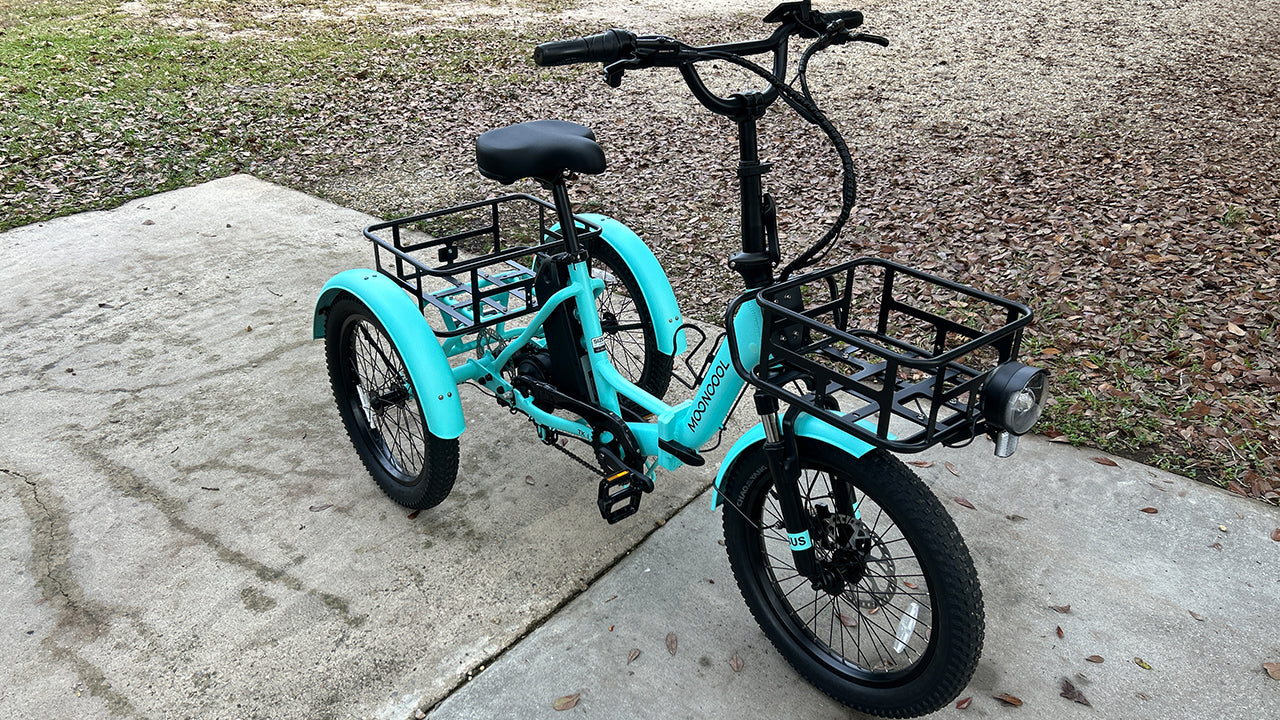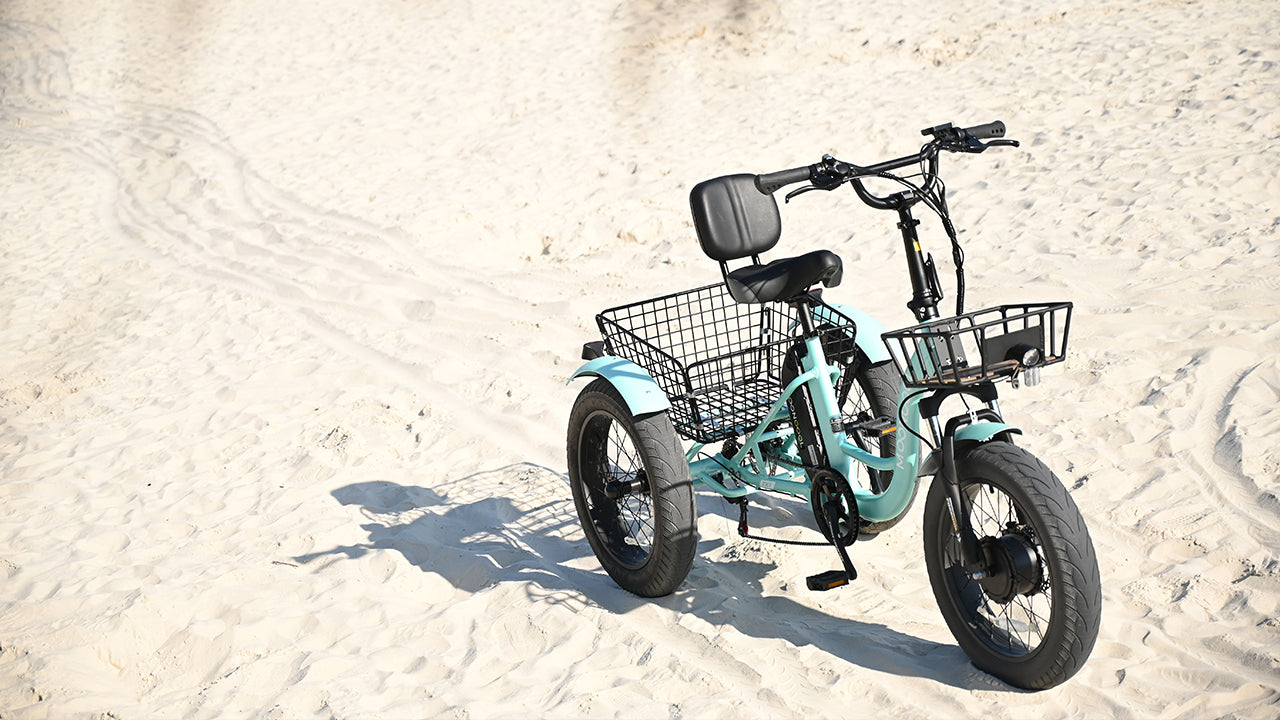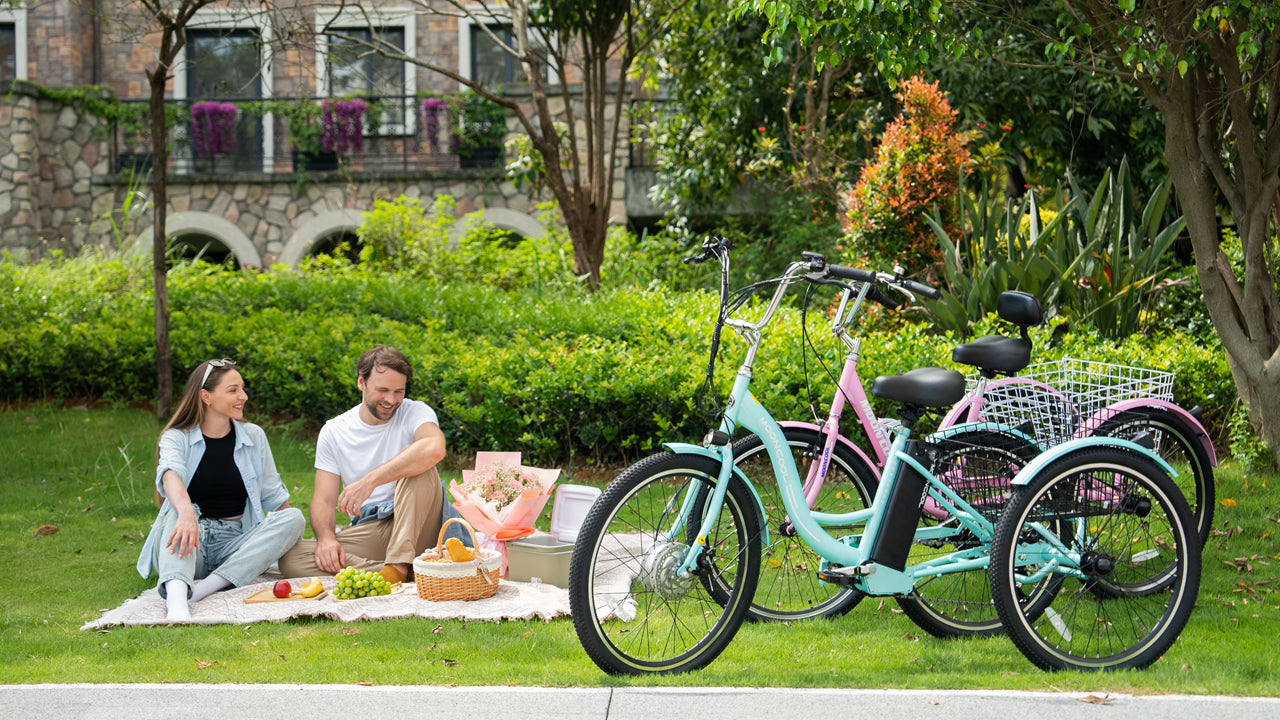Tired of the same old bike ride? Electric trikes provide a fun twist on cycling using pedal-assist motors to make riding fast, easy, and adventurous. With improved stability from their three wheels and convenient features like cargo hauling and folding frames, electric trikes are surging in popularity for commuting, recreation, and beyond. This guide will explore the pros, cons, and types of e-trikes to help you decide if joining the electric trike movement is right for your lifestyle and budget. With the power boost of an electric motor, trikes can take your ride to exciting new places.
The Fundamentals of Electric Trike Designs and Capabilities
An electric trike is a tricycle with an integrated electric motor for pedal assistance. The motor augments human power, making it easier to accelerate, climb hills, and cover long distances with less fatigue. Electric trikes come in many configurations, but most resemble standard upright or recumbent bicycles with an extra rear wheel for stability.
Key features that set electric trikes apart include:
- Motor type- Most models use pedal-assist hub motors built into the front or rear wheel. Front-wheel drive configurations on e-trikes can enhance stability and traction, particularly during takeoff, ensuring a smoother and safer ride, especially for those who may be new to three-wheeled cycling. Motors typically range from 250-750 watts.
- Battery- Lithium batteries ranging from 10-20+ AH offer 15-50+ miles of range on a single charge. Batteries take 2-8 hours to fully recharge.
- Design- Frame materials include aluminum, steel, or carbon fiber. Recumbent styles prioritize ergonomics, while upright trikes mimic standard bike positioning. Fat tire trikes feature oversized tires for all-terrain riding.
- Accessories- Cargo trikes allow you to haul pets or gear. Folding trikes collapse for easy storage and transport. Customizable accessories range from lights to racks, fenders, bells, and more.
With the power boost from an electric motor, trikes can make light work of hills, headwinds, and longer distances that might be challenging on a standard bike. Their stable 3-wheel stance also provides balance assistance. Common uses include urban commuting, recreational rides, leisurely touring, grocery shopping, and more.
Types of Electric Trikes and Their Best Uses
Electric trikes come in many styles tailored to different needs and preferences. Key categories include:
1. Cargo Electric Trikes
Best for: Shopping, deliveries, pets transportation
With their expanded rear cargo area, electric cargo trikes allow you to haul pets, groceries, and more. The long wheelbase provides stability even when fully loaded. Stronger frame materials, tires, drivetrains, and brakes ensure durability under heavy loads. Cargo trikes are ideal for urban tasks like grocery shopping, local deliveries, or safely transporting pets. The electric assist makes hauling heavy cargo easy and expands your usable range.
2. Recumbent Electric Trikes
Best for: Long rides, touring, back pain relief
Recumbent trikes let you recline in a chair-like seat rather than hunch over handlebars. This ergonomic position redistributes weight to relieve pressure on your hands, wrists, neck, and back. The semi-reclined posture also enhances comfort on long rides. For those with back troubles, recumbent trikes provide low-impact exercise. The pedal-assist motor aids with climbing hills in the laid-back position. Perfect for leisurely cruising, touring, or commuting moderate distances.
3. Folding Electric Trikes
Best for: Urban commuters, multi-modal trips, storage challenged
A folding electric trike combines compact convenience with electric power. In seconds, it collapses down to a fraction of its full size for storage or transport. Ideal for urban commuters with limited living space or multi-modal commuters combining cycling and public transit. The electric assist offsets the smaller wheel size, making short-distance trips around town easy. When folded, most models roll on their wheels for easy maneuverability.
4. Fat Tire Electric Trikes
Best for: Off-road adventures, beach riding
Fat tire trikes feature oversized, balloon-like tires measuring 3-5 inches wide. The huge contact patch provides traction on snow, sand, and rugged trails. A front suspension soaks up bumps and vibration when venturing off-road. While slower than standard trikes, the fat tires deliver stability and comfort on uneven terrain. Perfect for adventurous types wanting to ride on the beach, explore backcountry trails, or commute through snowy conditions.
The Pros of Electric Trikes: Why Go Electric?
Electric trikes offer compelling benefits that enhance cycling's enjoyment and everyday utility. Let's explore the top reasons riders are going electric:
Effortless Cruising
An electric motor assists your pedaling with power boosts, enabling you to ride faster and farther without fatigue. Hills and headwinds pose no challenge. It's ideal if you have limited mobility or prefer a relaxed pace.
Cargo-Hauling Made Easy
With ample, stable cargo space, trikes let you conveniently transport pets, groceries, and gear. The electric assist takes the strain out of hauling heavy loads. It is far more practical for errands than a standard bike.
Inherent Stability
With three wheels solidly grounded, e-trikes provide unbeatable stability and effortless balancing - even when stopped. Great for beginners. The stability inspires confidence on slippery terrain too.
Gentle Exercise
The electric assist motor enables gentle, low-impact pedaling that can aid in injury recovery or for those unable to tolerate high-strain activities. With the motor providing extra power, riders can pedal to get their blood flowing and muscles activated without having to push themselves to the point of pain or re-injury.Electric trike are good for the joints of the body: Stay Active with E-Trikes: Gentle on Knees and Joints for Seniors' Fitness
Pure Fun
Gliding along with less exertion is a blast! Cargo trikes enable bringing the whole family along for the ride. The electric motor adds an element of adventure.
Eco-Friendly
E-trikes run silently on clean electricity rather than gasoline. For local trips, they greatly reduce your carbon footprint.
Help you learn about more difference: Electric Trikes vs. Traditional Trikes: Which Is Better for You?
The Cons of Electric Trikes: Factors to Consider
While e-trikes have many benefits, there are also some downsides to weigh:
Higher Costs
E-trikes are pricier than standard trikes. Entry-level models start around $700, mid-level e-trikes typically range from $1000 to $2000, offering a balance of features and performance, and high-end electric trikes can cost $5000+. Also budget for ongoing battery replacement. But costs are dropping.
Heavier to Transport
The added weight from motors and batteries can make transporting e-trikes trickier. You may need a vehicle rack or bike trailer. Folding trikes provide a lighter option.
More Frequent Maintenance
The electrical components require regular professional service - more than a standard bike. DIY repair options are limited.Come here to learn more maintenance tips: Electric Trike Maintenance Tips: Keeping Your Trike in Top Condition
Limited Range
Most e-trikes travel 15-50 miles on a single charge. Carefully plot routes based on range and consider backup batteries for longer trips.
Bulkier Storage
Cargo trikes have a larger footprint, so ensure you have adequate storage space. Folding trikes help maximize space savings.
| Pros of Electric Trikes | Cons of Electric Trikes |
|---|---|
| Effortless cruising with power-assisted pedaling | Higher upfront costs compared to standard trikes |
| Cargo-hauling made easy with ample space | Heavier to transport due to motor and battery |
| Inherent stability from three-wheel design | More frequent maintenance required |
| Gentle exercise, good for injury recovery and seniors | Limited range on a single charge |
| Pure fun and adventure with less exertion | Bulkier storage needs than two-wheeled bikes |
| Eco-friendly, running on electricity instead of gasoline |
Key Questions to Ask Before Buying an Electric Trike
If you're seriously considering an electric trike purchase, here are some important questions to ask yourself:
How will the trike be used?
For a daily commute to work, it is about 5 miles each way. An upright e-trike with cargo capacity would likely suit those needs best.
Is there space to store it?
There is space in a garage to store the trike, but a heavy-duty wall rack would be needed to hang it vertically and save floor space.
Does it fit the budget?
A budget of $700-1500 allows for an entry-level model. Another $200 per year should be factored in for battery replacement costs.
What is the typical riding range?
A work commute is 10 miles roundtrip. Weekend rides on trails can be 20-30 miles. A 30-45 mile battery range would cover most needs.
Don't forget to test ride multiple models to get a feel for fit, comfort, and handling. Take each one on both flat roads and hills. Ask retailers questions about service plans and warranties. Once purchased, follow the manufacturer's maintenance schedule and guidelines to keep your electric trike in optimal riding condition. Adopt safe riding practices, including wearing a helmet and riding defensively.
Experience the Electric Trike Difference
Electric trikes offer a fun, sustainable way to get around while expanding mobility for riders of all ages and abilities. With pedal-assist engines providing a power boost, trikes make cycling more accessible and practical in urban areas or on longer recreational rides. Choosing the right style for your needs and budget will ensure you get the most out of your e-trike. Test rides and research help set realistic expectations around factors like range, cargo capacity, and more. As a green alternative for personal mobility, electric trikes are reshaping transportation in cities and suburbs alike.







Leave a Comment
This site is protected by hCaptcha and the hCaptcha Privacy Policy and Terms of Service apply.